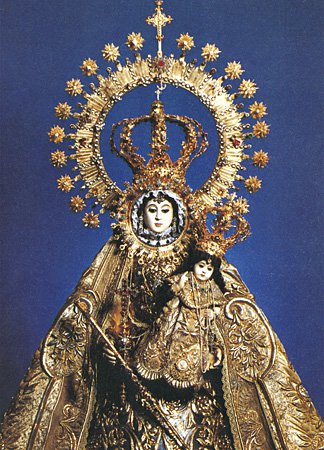Cultural Center of the Philippines
ENCYCLOPEDIA OF
PHILIPPINE ART
Our Lady of La Naval / Nuestra Señora del Santisimo Rosario de la Naval
(Lady of the Navy) aka Nuestra Señora del Santisimo Rosario (Our Lady of the Most Holy Rosary) / 1593 / Ivory and wood / 136 cm / Unknown Chinese artist / Roman Catholic Parish Church of Santo Domingo, Quezon City
After the first church of the Dominicans was burned circa 1590, a new church also dedicated to the Nuestra Señora del Santisimo Rosario was built. For this church, a new image with ivory hands and face was given as a gift by acting governor-general Luis Perez de Dasmariñas. A de bastidor (hoop)-type image, the Virgin has ivory head and hands attached to a wooden body, which has an andador or wooden frame for a skirt. The child is carved entirely in ivory. The santo was carved by a non-Christian Chinese from Ilocos under the direction of Capt Hernando de los Rios Coronel.
In 1646 the Dutch attacked the Philippines. Five naval battles ensued near Marinduque. Although greatly outnumbered, the Spanish fleet defeated the Dutch Armada. It was believed that the Virgin’s intervention secured Spanish victory. From then on the Virgin’s image has been honored with a feast, called La Naval de Manila, on the second Sunday of October.
The image has been housed in the Santo Domingo Church of the Dominicans, including the last in Intramuros, which was a neo-Gothic structure designed by Felix Roxas Sr. Damaged during the British invasion in 1762, the image was subsequently restored.
The image consists of a woman with a maternal face punctuated by almond-shaped eyes, which identify its maker, and a chubby child Jesus with proper folds of baby fat. Ivory, a soft material, lent itself to fine craftsmanship.
The image is precious not only for its ivory but for its costume and accessories. Her great veil embroidered with gold metal thread and its plancha (beaten and embossed silver), forming the front part of her chemise and skirt, are from the 19th century. She has a set of aureola (halo), rostrillo (rays around the face), and corona (the last with a smaller version for the Niño)—all circa 1811. To symbolize her authority she holds a governor-general’s baston (cane), which holds a row of episcopal rings donated by Dominican bishops. For her canonical coronation in 1907, donations of jewelry and cash from all over the Islands were gathered to create a gift for her and her child—two crowns of 18-karat gold created by Estrella del Norte. In 1908 a scepter of 18-karat gold was designed for her by Crispulo Zamora, which was topped by the pectoral cross given by Archbishop Gonzales of Toledo, Spain. Her gala rosary is made of Sulu pearls, with a cross of rose-cut diamantes (black diamonds).
Before World War II the grandest celebration in Intramuros was that of La Naval, described as “la procesion de las procesiones” (the procession of all processions). It thus occupied a central place in the consciousness of the Manileño.
Fray Francisco Gainza, later Bishop of Nueva Caceres (now Naga), wrote Milagros y Novena de Nuestra Señora del Rosario (Miracles and Novena of Our Lady of the Rosary), an account of the miracles wrought at the intercession of the Virgin. Nick Joaquin’s A Portrait of the Artist as Filipino ends with the La Naval procession, the symbol of a culture and way of life about to fade as Manila faced modernity.
Written by Rene B. Javellana and Nicanor G. Tiongson
